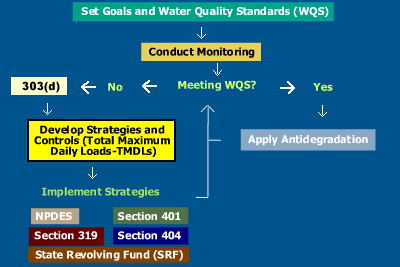
Watershed Academy Web
Introduction to the Clean Water Act

This diagram provides further details on what will be discussed in this module.
To view the entire module, in order, click on the "next" arrow at the top of the screen, and continue to do so after you finish reading each screen. The module goes through the major CWA programs in the following sequence: 1) water quality standards, 2) antidegradation policy, 3) waterbody monitoring and assessment, 4) reports on condition of the nation's waters, 5) total maximum daily loads (TMDLs), 6) NPDES permit program for point sources, 7) Section 319 program for nonpoint sources, 8) Section 404 program regulating filling of wetlands and other waters; 9) Section 401 state water quality certification; 10) state revolving loan fund (SRF).
Also, at any time, you can jump to the slides about a particular CWA program, by clicking on the "CWA Big Picture" link in the navigation tool bar -- at the top of the screen. For example, if you want to go to the unit on the Section 319 nonpoint source program, first click on "CWA Big Picture" in the tool bar, and then click on the brown box labeled "Section 319," in the lower left corner of the Big Picture slide.
Throughout the module, underlined terms are hyperlinked to the glossary (see also the "glossary" link at the upper right corner of your screen). If this is your first visit to a Watershed Academy module, click the "how to navigate Watershed Academy modules" link for other general browsing instructions.
This course may take several hours to complete. Students may vary the depth of the course by choosing to read only the left slides, the right side text, or both. Also, throughout the module, there are numerous links to other websites providing additional details on particular programs or topics. These are strictly optional, and not essential to understanding the basics of the CWA. Exploring these additional informational resources can easily double or triple the amount of time it takes to navigate this module.
Brief Overview of Key CWA Elements
First, water quality standards (WQS) consistent with the statutory goals of the CWA must be established. Then waterbodies are monitored to determine whether the WQS are met.
If all WQS are met, then antidegradation policies and programs are employed to keep the water quality at acceptable levels. Ambient monitoring is also needed to ensure that this is the case.
If the waterbody is not meeting WQS, a strategy for meeting these standards must be developed. The most common type of strategy is the development of a Total Maximum Daily Load (TMDL). TMDLs determine what level of pollutant load would be consistent with meeting WQS. TMDLs also allocate acceptable loads among sources of the relevant pollutants.
Necessary reductions in pollutant loading are achieved by implementing strategies authorized by the CWA, along with any other tools available from federal, state, and local governments and nongovernmental organizations. Key CWA tools include the following:
After implementation of these strategies, ambient conditions are again measured and compared to ambient water quality standards. If standards are now met, only occasional monitoring is needed. If standards are still not being met, then a revised strategy is developed and implemented, followed by more ambient monitoring. This iterative process must be repeated until standards are met.